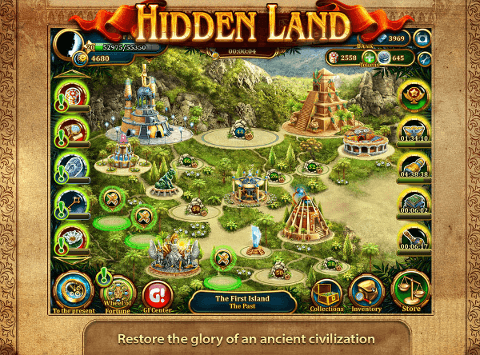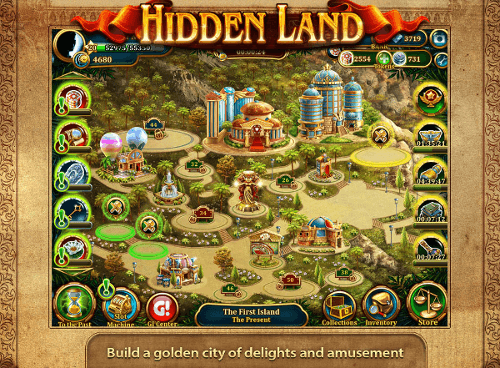- Wondering how to get Monopoly GO! free rolls? Well, you’ve come to the right place. In this guide, we provide you with a bunch of tips and tricks to get some free rolls for the hit new mobile game. We’ll …
The BEST Roblox Games of The Week – Games You Need To Play!
By Sho Roberts
Our feature shares our pick for the Best Roblox Games of the week! With our feature, we guarantee you'll find something new to play!Best Roblox Horror Games to Play Right Now – Updated Weekly
By Adele Wilson
Our Best Roblox Horror Games guide features the scariest and most creative experiences to play right now on the platform!Type Soul Clan Rarity Guide – All Legendary And Common Clans Listed!
By Nathan Ball
Wondering what your odds of rolling a particular Clan are? Wonder no more, with my handy Type Soul Clan Rarity guide.
Hidden Land Review
If you’ve ever sat down with a free-to-play hidden object game before, then you probably have some idea of what you’ll be in for with Game Insight’s latest addition to the genre, Hidden Land. Set in a dual timeline between the present and past versions of an ancient society, you’ll blitz through exciting hidden object scenes, tackle night levels and scrambled words lists, and recapture the spirit of a long-forgotten cultural history.

Hunt for ancient artifacts throughout the present and the past in this fun hidden object social game!
If you’ve ever sat down with a free-to-play hidden object game before, then you probably have some idea of what you’ll be in for with Game Insight’s latest addition to the genre, Hidden Land. Set in a dual timeline between the present and past versions of an ancient society, you’ll blitz through exciting hidden object scenes, tackle night levels and scrambled words lists, and recapture the spirit of a long-forgotten cultural history.
It’s rare these days to find a free-to-play hidden object game that isn’t bogged down by in-app purchases, or one that lets you search a whopping three or four scenes before your energy fully depletes and you either have to wait a few hours for it to regenerate, or give in and just buy some more. Mobile developers should take a lesson from Hidden Land, as the game finds that sweet spot between a playable freemium “demo” and a full-fledged game release. I think the reason why the model works so well here is because you level up so quickly in the game, refilling your energy meter each time, and showering you with a number of other rewards. One time after leveling up, I was actually shocked to see the game had rewarded me with 5 crystals, Hidden Land‘s rarest form of currency.
Hidden Land features 9 different hidden object locations, but with a past and present version of each. So for instance, the gleaming Temple of Time and The Sovereign’s Palace in the past become the Temple Ruins and the Palace Ruins in the present, and the old Observatory becomes a futuristic Research Station in modern times. Switching back and forth between the past and the present is as easy as the tap of the button, and while most past/present counterparts are relatively the same, you’ll still notice a few graphical changes to differentiate between them: especially in the dilapidated features of the ruins locations. But as a whole, the graphics are always colorful and vibrant, and Game Insight did a really nice job at capturing the feel of this ancient, tribal world.
The game moves at a blistering pace, but almost to a fault at times. You’ll barely finish one objective when your screen gets bombarded with a handful of pop-up notifications from other NPCs asking you to do this or that. In fact, half of my time with the game was probably spent on closing these notifications than anything else. I even had to stop reading them all after a while, because I wanted to play a game here, and not read a book. The upside to this is that you’ll always have four or five different missions to work on at once, and you’ll never run out of things to do in your quest log to boost that EXP.
In addition to the main storyline, the game also offers a number of fun and exciting side quests to help pass the time and build up your totals. You can gamble on a blinking slot machine in the present or on an ancient fortune wheel in the past, and help out random citizens by finding and assembling certain sets of collectables. But perhaps the crowning achievement here is Hidden Land’s intriguing city-building component. In both the past and present world maps, there are dozens of empty land plots, which are gradually opened up depending on your character level. Each statue and landmark you build will grant you a specific perk over time, such as giving you 1 Sun Token every 2 minutes, or adding on to your total Harmony score. You’re also free to move your landmarks to any open locations after you build them. The only issue I had with this is that the city-building aspects seem to forgo the past/present relationship that the rest of the game has been founded on. If I build a statue in the past, shouldn’t it show up in the same location in the present? Unfortunately, that doesn’t seem to be the case here.
So in the end, Hidden Land brings some nice ideas to the free-to-play hidden object genre, like dual timelines and city-building components. And best of all, it actually gives you the freedom to experience them! The hidden object scenes and social aspects of the game are pretty evenly balanced, and it never feels like one is overpowering the other. With so much to do and see in this game, you’ll start to wish you had a separate timeline all to yourself, where you didn’t have to work or go to school, and could just spend all day in this fascinating Hidden Land!

The good

The bad
More articles...
Monopoly GO! Free Rolls – Links For Free Dice
By Glen Fox
Wondering how to get Monopoly GO! free rolls? Well, you’ve come to the right place. In this guide, we provide you with a bunch of tips and tricks to get some free rolls for the hit new mobile game. We’ll …The BEST Roblox Games of The Week – Games You Need To Play!
By Sho Roberts
Our feature shares our pick for the Best Roblox Games of the week! With our feature, we guarantee you'll find something new to play!Best Roblox Horror Games to Play Right Now – Updated Weekly
By Adele Wilson
Our Best Roblox Horror Games guide features the scariest and most creative experiences to play right now on the platform!Type Soul Clan Rarity Guide – All Legendary And Common Clans Listed!
By Nathan Ball
Wondering what your odds of rolling a particular Clan are? Wonder no more, with my handy Type Soul Clan Rarity guide.








 “
“